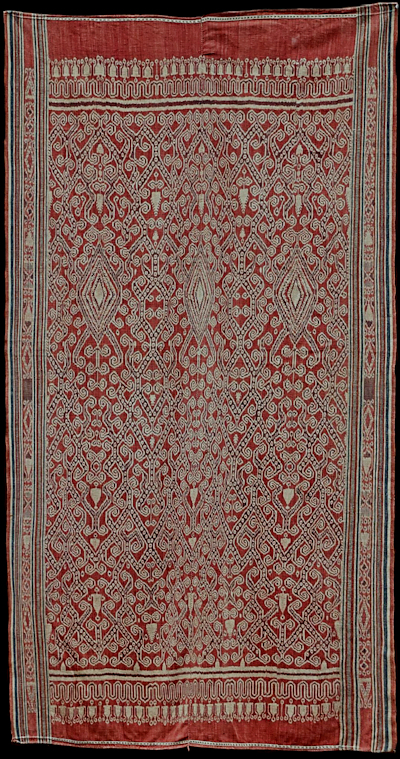| |
 
 | | | |
155 Borneo, Sarawak
Pua kumbu 
| | Locale: | Possibly Batang Ai or Mujong River area. | | Period: | 19th or very early 20th c. | | Yarn: | Cotton, hand-spun, medium | | Technique: | Warp ikat | | Panels: | 2 | | Size: | 120 x 228 cm (3' 11" x 7' 5") LW: 1.90 | | Weight: | 850 g (30.0 oz), 311 g/m2 (1.02 oz/ft2) | | Design: | A pua kumbu from a region southeast of the Saribas, of the class that is suitable for receiving heads. The design is a very unusual variant of the motif that for short is called selempepat, more fully 'batang sepepat (selempepat) tebok igi bras', or tree with branches outlines by the light of fireflies (see Ong, below). On account of its unusual variation Vernon Kedit assumes it to be a buah tengkebang, or creative new invention by its weaver. The diamond lozenges in the upper half most likely represent a trophy heads. Omen birds mark the ends. | | Comment: | [PHOTOGRAPHY PROVISIONAL] A pua with strong, clear ikat, clearly the work of an experienced, older weaver. The photo shows the cloth the right way up. The weaver began with four coils per fold (this is a three fold) and ended with five coils - which means one fold exceeded 80 counts of warp bundles. Designs on 80 or more counts are usually important, and not the usual innocuous patterns woven by young novices. Microscopy reveals the expected hand-spun yarn, brittle with age. | | Background: | Chapters on Borneo and Sarawak. | | Sources: | A variant of a design type shown in Ong, Pua, Iban Weavings of Sarawak, Plate P7 (Richard Yong collection) with motif identified as 'batang sepepat (selempepat) tebok igi bras', and to one on P18 (Edric Ong collection). Quite similar to pua from the Mujong River area of Borneo, dated simply as '20th century', in Honolulu Museum of Art accession 10380.1. Similar to pua with buah sepepat in Gavin, Iban Ritual Textiles, Fig. 47 and one identified as having vine pattern, ampang berinjang, in Fig. 158. Also similar to 19th c. pua from the Charles Hose collection in British Museum, As1905-410. | | |

©Peter ten Hoopen, 2025
All rights reserved.
|
|


